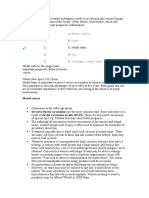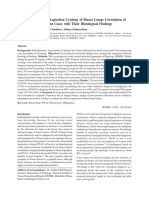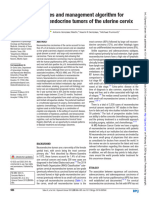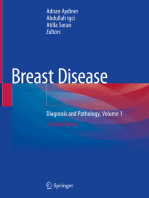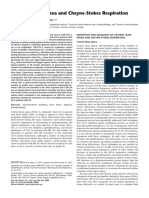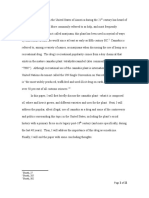Phyllodes Tumors
Phyllodes Tumors
Uploaded by
Nexi anessaCopyright:
Available Formats
Phyllodes Tumors
Phyllodes Tumors
Uploaded by
Nexi anessaOriginal Description:
Copyright
Available Formats
Share this document
Did you find this document useful?
Is this content inappropriate?
Copyright:
Available Formats
Phyllodes Tumors
Phyllodes Tumors
Uploaded by
Nexi anessaCopyright:
Available Formats
ORIGINAL ARTICLE
Malignant phyllodes tumors of the breast: A single
institution experience
Liew Kah Weng, MB BCH BAO, Siti Zubaidah Sharif, MS, Doreen Lee, MS
Breast and Endocrine Department, Hospital Queen Elizabeth 2, Kota Kinabalu, Sabah
ABSTRACT
Background: Malignant phyllodes tumors of the breast are
to malignant phyllodes.4 These aggressive tumors accounts
uncommon fibroepithelial breast tumors with diverse
for less than 0.5% of all breast malignancies.1 The
biological behavior. Our study aim is to share our
recommended treatment of phyllodes tumor remains surgery.
experience in treating patients with malignant phyllodes
Mastectomy and breast conserving surgery can be carried out
presenting to our center.
with a margin of at least 1cm to treat this tumor effectively.1,5
However the local recurrence rate following breast conserving
Patients and methods: A total of 11 cases of malignant
surgery are 8% for benign phyllodes tumors and 21-36% for
phyllodes were retrospectively reviewed between Nov 2014
borderline and malignant tumors.5,6 Lymph node
and Oct 2017. Results: The median age was 45 years old (31-
involvement is rarely found in phyllodes tumor. So the role of
61 years). The median pathological tumor size was 10.5cm
axillary dissection has been a debate among breast surgeons.
(2-28cm). 6 patients (55%) were premenopausal. 7 patients
Axillary node sampling could be considered for high risk
(64%) were treated eventually with mastectomy and 4 (36%)
patients. 7
were treated with breast conserving surgery. 4 (36%)
patients had Axillary Clearance done while axillary sampling
Postop adjuvant radiotherapy for malignant phyllodes
was done in 2 patient. The remainder 5 (45%) required
tumors has also been recommended as it has shown to be
axillary clearance at a later op. 6 (55%) patients received
effective in decreasing recurrence rates after breast
postoperative radiotherapy. After a median follow up period
conserving surgery.6 Subsequently, malignant phyllodes
of 11 months (range 4-33 months), 8 developed local
usually presents as a huge tumor involving more than 1
recurrence. The overall 2 year survival rate was 18%.
quadrant so achieving wide margins of > 1cm can be
challenging even if a total mastectomy was performed. Some
Conclusion: Malignant Phyllodes tumors are rare tumors
studies have indicated that RT will help to reduce recurrence
that occur in fairly young women, when compared with the
in these patients.6
adenocarcinoma of the breast. They tend to grow to reach
large with absence of nodal metastasis. Ultimately surgery
The role of adjuvant chemotherapy is highly debatable. Most
is the mainstay of management but with postoperative
patients present with huge masses and ulcerating tumors
radiotherapy it can decrease the local recurrence rates in
with distant metastasis. These patients are usually not fit for
certain presentations however recurrence rate is high and
chemotherapy and a through discussion should be conducted
overall survival rates are poor.
with the breast surgeon, oncologist and the patient to weight
the risks and benefits of the treatment. Some of the tumors
KEY WORDS:
may have positive hormone receptors in their epithelial
component however hormonal therapy has been shown not
Breast, phyllodes, surgery, radiotherapy, follow up, survival rate to be effective.8
INTRODUCTION
So the mainstay of treatment is with surgery and with or
without adjuvant radiotherapy. The survival rate for
Malignant phyllodes tumors of the breast are rare malignant phyllodes tumors has be reported to me 60-80% at
fibroepithelial breast tumors that acts aggressively and 5 years.9 Patients with metastatic disease do less well with 13-
usually presents as a huge tumor of the breast. They can be 40% 5 year survival rate. 9 The most frequent metastasis
classified as benign, borderline or malignant1,2 according to usually involves the lung. The mean survival is 30 months
the degree of stromal cellular atypia, mitotic activity, after the development of metastases.10
infiltrative versus circumscribed tumor margins and presence
AIM OF THE STUDY
or absence of stromal overgrowth.3 The benign form may act
similar to fibroadenomas while the malignant form tends to
grow rapidly and may present with distant metastasis. This is a retrospective study to look at the presentation,
Unfortunately, even with wide excision margins, these pathological features, prognostic factors and treatment
tumors have a very high local recurrence rate.2 outcomes for patient who presented with malignant
phyllodes tumors of the breast to Breast and Endocrine
From a histopathological viewpoint, the stromal elements are Department, Hospital Queen Elizabeth 2, Kota Kinabalu,
the key components in differentiation of phyllodes tumor Sabah (HQE2).
from giant fibroadenoma or distinguishing it from a benign
This article was accepted: 2 August 2018
Corresponding Author: Kah Weng Liew
Email: weng55@hotmail.com
Med J Malaysia Vol 73 No 5 October 2018 297
Original Article
Table I: Demographic data of patients presenting with malignant phyllodes
PATIENTS AND METHODS benign core biopsy results while 4 had suspicious lesion noted
The medical records of HQE2 were accessed and all diagnoses from core biopsy. Initially, 4 patients (36%) were planned for
made of malignant phyllodes tumors of the breast were breast conserving surgery , unfortunately the surgical
extracted. HQE2 is the only tertiary hospital with breast and margins were all involved except for 1 patient. Secondary
endocrine surgical unit with 2 experienced breast and surgery which was a mastectomy with axillary clearance was
endocrine surgeons providing care for the whole of Sabah. A performed in the other 3 patients. Definitive surgery of
search of the records from Nov 2014 to October 2017 revealed mastectomy and axillary clearance was carried out in 7
a total of 11 interesting cases of malignant phyllodes tumors. patients (64%). Axillary node sampling was performed for 2
The clinical and pathological data were studied patients which resulted in reactive lymph nodes free from
retrospectively from the medical and pathological records. tumor infiltration. 7 patients had axillary clearance done
and only one patient had positive lymph nodes. 9 patients
RESULTS
presented with huge tumors involving more than 1 quadrant.
The median pathological tumor size was 10.5cm (2-28cm). 6
The demographic data of the 11 patients are summarized in patients had adjuvant RT (5 following mastectomy and 1
Table I. All 11 patients were female with a median age of 45 after BCS). The dose of post mastectomy RT was 50Gy/25# in
years old (31-61 years) at time of diagnosis. These patients two patients while one had additional boost 10Gy/5#.
were followed up closely in the clinic with a median of 11 Following breast conserving surgery, the RT dose was
months (range 4-33 months). 6 patients (55%) were 50Gy/25# in two patients and 60Gy/30# for the one patient.
premenopausal. All of the patients presented with a breast Unfortunately, 4 patients post adjuvant RT had local
mass with a median duration of symptoms of 24 months (2- reoccurrence.
360months). Only 1 patient had a positive family history of
breast malignancy. 4 patients had mammography done In our sample group only 2 patients had distant metastasis.
reported as recurrent phyllodes tumor, BIRADS 3, BIRADS 4 One had lung nodules and the other had lung and liver
and BIRADS 5. Ultrasonography of the breast was employed lesions. 8 patients had local reoccurrence. 3 patients were
in 2 patients which shows suspicion of breast malignancy treated with mastectomy after the initial breast conserving
and benign breast lesion. Core biopsy revealing malignant surgery. Surgical Margins were involved in 3 patients with 2
phyllodes tumor was only found in 3 patients. 2 patients had patients requiring a later mastectomy. Throughout the follow
298 Med J Malaysia Vol 73 No 5 October 2018
Malignant phyllodes tumors of the breast: A single institution experience
Fig. 1: Patient with huge phyllodes tumor. Fig. 2: Patient with huge phyllodes tumor.
Fig. 3: Patient with ulcerating and bleeding phyllodes tumor. Fig. 4: Patient with huge phyllodes tumor.
up, four patients were still alive at the end of October 2017. Phyllodes tumors tend to present as a huge breast mass with
Unfortunately, the overall 2 year survival rate from time of abnormal mammographic findings. Our study found that
diagnosis was 18%. the median tumor size is 10cm with one case presenting as
ulcerating and bleeding breast mass. Other literature has
DISCUSSION
shown the median size to be 4-7cm.1
Malignant phyllodes tumors of the breast are rare rumors For phyloddes tumor, it is usually reported as a smooth,
with an average annual incidence of 2.1 per million women.3 polylobulated mass resembling fibroadenoma in
We studied 11 female patients diagnosed with this disease mammography. However in our setting, mammography is
presenting to our centre. We found that malignant phyllodes seldom performed as patient usually present very late with a
tumors of the breast tend to present at a younger age very huge mass and locally advanced disease deeming them
population compared to breast cancer. The median age in unsuitable for mammography. In our study only 4 patients
our study was 45 years compared to 50 years for breast cancer had a mammography done. The huge mass at presentation
in Malaysia11 and comparable to 42-45 years worldwide.3 and rapid growth will raise suspicion for a phyllodes tumor
rather than a fibroadenoma.2 Core biopsy was done in most
of our cases as that is the standard of care before surgical
intervention was carried out.
Med J Malaysia Vol 73 No 5 October 2018 299
Original Article
In our study only 2 core biopsy results reported as malignant CONCLUSION
phyllodes tumor of the breast while one had borderline Malignant phyllodes tumors of the breast are rare tumors
phyllodes tumour reported. Another 2 core biopsy revealed that occur in relatively young woman when compared to
necrotic breast tissue with inflammatory cells and atypical breast cancer. They have a tendency to grow into very large
spindle cell lesion of uncertain malignant potential and 1 breast mass with the absence of axillary nodal metastasis.
revealed benign fibrous stroma. Subsequently all mastectomy Total mastectomy or breast conserving surgery is the gold
and breast conserving surgery specimen yield malignant standard of treatment for these cases and postop adjuvant
phyllodes tumors of the breast. radiotherapy has proven to decrease local recurrence rate.
From our data, although the 2 year survival rate was very low
We also found that, 3 patients had positive surgical margins we should not be discouraged. In our setting, most patients
with 2 undergoing breast conserving surgery. This could be present very late with very huge breast mass and distant
explained by the infiltrative nature of the tumor. Ultimately, metastases. To combat this we must spend more time on
10 patients required mastectomy as their initial surgery or understanding this breast disease and patient education and
after their breast conserving surgery to treat this tumor. Only awareness is very important so that we can treat this disease
one patient had a wide local excision and adjuvant effectively.
radiotherapy after not requiring mastectomy but this could
REFERENCES
be explained by the small tumor size of 2.5cm.
Although axillary lymph node involvement is rarely 1. Reinfuss M, Mitus´ J, Duda K, Stelmach A, Rys´ J, Smolak K. The treatment
and prognosis of patients with phyllodes tumor of the breast: an analysis
described in phyllodes tumor12, 2 patients had axillary node
of 170 cases. Cancer 1996; 77: 910-16.
sampling done and 7 patients had axillary clearance done. 2. Calhoun KE, Lawton TJ, Kim JN, Lehman CD, Anderson BO. Phyllodes
Nodal metastasis was only detected in one patient. Literature tumors. In: Harris J, Lippman ME, Osborne CK, Morrow M, editors.
has shown that axillary dissection was not recommended in Diseases of the breast. Philadelphia: Lippincott Williams &Wilkins; 2010.
p. 781-92.
these cases but it was carried out in our center due to the huge 3. Bernstein L, Deapen D, Ross RK. The descriptive epidemiology of
mass on presentation and the likelihood of defaulting follow malignant cystosarcoma phyllodes tumors of the breast. Cancer 1993; 71:
up as most patients are from rural areas.12 3020-4.
4. Norris HJ, Taylor HB. Relationship of histologic features to behavior of
cystosarcoma phyllodes. Analysis of ninety-four cases. Cancer 1967; 20:
Studies have shown that adjuvant radiotherapy can lower 2090-9.
the rates of local reoccurrence in malignant phyllodes 5. Barth Jr RJ, Wells WA, Mitchell SE, Cole BF. A prospective, multi-
tumors.13 A total of 6 patients in our study underwent institutional study of adjuvant radiotherapy after resection of malignant
phyllodes tumors. Ann Surg Oncol 2009; 16: 2288-94.
adjuvant radiotherapy however only 2 patients did not 6. Barth Jr RJ. Histologic features predict local recurrence after breast
experience local reoccurrence after radiotherapy. conserving therapy of phyllodes tumors. Breast Cancer Res Treat 1999; 57:
291-5.
7. Ramakant P, Chakravarthy S, Cherian JA, Abraham DT, Paul MJ.
The local recurrence rate in our study was 72% (8 out of 11
Challenges in management of phyllodes tumors of the breast: a
patients) compared to the recurrence rates reported in retrospective analysis of 150 patients. Indian J Cancer. 2013; 50(4): 345-8.
literature (8-19%).13 3 patients required total mastectomy post 8. Telli ML, Horst KC, Guardino AE, Dirbas FM, Carlson RW. Phyllodes
BCS to treat the local recurrence. Only 2 patients had distant tumors of the breast: natural history, diagnosis, and treatment. J Natl
Compr Canc Netw 2007; 5: 324-30.
metastasis in our study. One had lung nodules and the other 9. Chaney AW, Pollack A, McNeese MD, Zagars GK, Pisters PW, Pollock RE,
had lung and liver lesions. et al. Primary treatment of cystosarcoma phyllodes of the breast. Cancer
2000; 89: 1502–11.
10. Kessinger A, Foley JF, Lemon HM, Miller DM. Metastatic cystosarcoma
In our center, all of the patient who was treated for
phyllodes: a case report and review of the literature. J Surg Oncol 1972; 4:
malignant phyllodes tumor of the breast were followed up at 131-4.
3 monthly intervals. The median follow up was 11 months 11. Hisham AN, Yip CH. Overview of breast cancer in Malaysian women: a
with a range of 4-33 months. This follows the same breast problem with late diagnosis. Asian J Surg 2004 Apr; 27(2): 130-3.
12. Macdonald OK, Lee CM, Tward JD, Chappel CD, Gaffney DK. Malignant
cancer follow up protocol defined by NCCN guidelines.14 phyllodes tumor of the female breast: association of primary therapy with
cause-specific survival from the Surveillance, Epidemiology, and End
Results (SEER) program. Cancer 2006; 107: 2127–33.
13. Pezner RD, Schultheiss TE, Paz IB. Malignant phyllodes tumor of the
breast: local control rates with surgery alone. Int J Radiat Oncol Biol Phys
2008; 71: 710-3.
14. NCCN guidelines of treatment of cancer by site: breast cancer. Ver. 1.2016.
http://www.nccn.org/professionals/physician_gls/pdf/breast.pdf
300 Med J Malaysia Vol 73 No 5 October 2018
You might also like
- C. C. Norkin, J. White, T. W. Malone - Measurement of Joint Motion - A Guide To Goniometry, Fourth Edition - F.A. Davis Company (2009) PDFDocument468 pagesC. C. Norkin, J. White, T. W. Malone - Measurement of Joint Motion - A Guide To Goniometry, Fourth Edition - F.A. Davis Company (2009) PDFSubham Das100% (11)
- Final 4.3 Health ANIMA Nov1 4.3Document12 pagesFinal 4.3 Health ANIMA Nov1 4.3Brendan KiernanNo ratings yet
- J Janardhan, P Venkateshwar, K Sreedhar Rao, K Sreedhar RaoDocument5 pagesJ Janardhan, P Venkateshwar, K Sreedhar Rao, K Sreedhar RaoNatalindah Jokiem Woecandra T. D.No ratings yet
- Prognostic Factors For Breast Cancer Recurrence After Conservative TreatmentDocument5 pagesPrognostic Factors For Breast Cancer Recurrence After Conservative TreatmentScivision PublishersNo ratings yet
- ManuscriptDocument5 pagesManuscriptAnisa Mulida SafitriNo ratings yet
- Radioterapia Tumor PhyllodesDocument5 pagesRadioterapia Tumor Phyllodesmanuel barrientosNo ratings yet
- The_Effect_of_Hypofractionated_Radiotherapy_on_TumDocument11 pagesThe_Effect_of_Hypofractionated_Radiotherapy_on_TumEskadmas BelayNo ratings yet
- Local Recurrence After Breast-Conserving Surgery and RadiotherapyDocument6 pagesLocal Recurrence After Breast-Conserving Surgery and RadiotherapyLizeth Rios ZamoraNo ratings yet
- The Role of Radiotherapy in Ovarian Cancer: ReviewDocument6 pagesThe Role of Radiotherapy in Ovarian Cancer: ReviewMaria MuñozNo ratings yet
- Reconstructive Outcomes in Patients WithDocument10 pagesReconstructive Outcomes in Patients WithtiaoyueasplNo ratings yet
- Primary Fibrosarcoma of Breast: A Rare Case Presentation: Cash ReportDocument4 pagesPrimary Fibrosarcoma of Breast: A Rare Case Presentation: Cash ReportBastiaanNo ratings yet
- Poster Paper Foo Kota Bengkulu NewDocument1 pagePoster Paper Foo Kota Bengkulu NewPoppy WulandariNo ratings yet
- Phyllodes Tumours: ReviewsDocument8 pagesPhyllodes Tumours: ReviewsMuhammad SubhiNo ratings yet
- Annals of Medicine and Surgery: M. Riis TDocument13 pagesAnnals of Medicine and Surgery: M. Riis TJacob AlajyNo ratings yet
- nejm乳腺癌Document8 pagesnejm乳腺癌shentujin1997No ratings yet
- Oncologic Principles in Breast ReconstructionDocument13 pagesOncologic Principles in Breast ReconstructionJose Mauricio Suarez BecerraNo ratings yet
- nihms966493Document25 pagesnihms966493Aman ChaudharyNo ratings yet
- Local Recurrence After Breast-Conserving Surgery and RadiotherapyDocument6 pagesLocal Recurrence After Breast-Conserving Surgery and RadiotherapyLizeth Rios ZamoraNo ratings yet
- C. Nodal Status: A. Mitotic Number B. GradeDocument46 pagesC. Nodal Status: A. Mitotic Number B. GradeOstazNo ratings yet
- Radiotherapy in Phyllodes Tumour: Abst TDocument3 pagesRadiotherapy in Phyllodes Tumour: Abst TtaufikolingNo ratings yet
- p63 Expression11Document6 pagesp63 Expression11isela castroNo ratings yet
- Benign Breast Papilloma: Is Surgical Excision Necessary?: Original ArticleDocument6 pagesBenign Breast Papilloma: Is Surgical Excision Necessary?: Original Articleyongky sugandaNo ratings yet
- Clinical Approach to Diagnosis and Management of Endometrial Hyperplasia and CarcinomaDocument18 pagesClinical Approach to Diagnosis and Management of Endometrial Hyperplasia and CarcinomatarasantraNo ratings yet
- A Leafy SurpriseDocument4 pagesA Leafy SurpriseFaliyaaaNo ratings yet
- Tata Laksana Kanker Payudara Relaps Laksana Kanker Payudara RelapsDocument7 pagesTata Laksana Kanker Payudara Relaps Laksana Kanker Payudara RelapsMaharani Aprilia SunevyNo ratings yet
- Extreme Oncoplasty Breast Conservation For Patients Who Need MastectomyDocument8 pagesExtreme Oncoplasty Breast Conservation For Patients Who Need MastectomyadynataciayadiNo ratings yet
- Diagnosis and Management of Phyllodes Tumors of The Breast: Ashley Simpson, Pamela Li, Jill DietzDocument7 pagesDiagnosis and Management of Phyllodes Tumors of The Breast: Ashley Simpson, Pamela Li, Jill DietzOttofianus Alvedo Hewick KalangiNo ratings yet
- Prognostic Factors in Phyllodes Tumor of The Breast: Are Immunohistochemical Biomarkers Useful?Document2 pagesPrognostic Factors in Phyllodes Tumor of The Breast: Are Immunohistochemical Biomarkers Useful?Harley Septian WilliNo ratings yet
- Re Ection and Reaction: ArticlesDocument2 pagesRe Ection and Reaction: ArticlesYacine Tarik AizelNo ratings yet
- Concer VDocument9 pagesConcer Vmoises vigilNo ratings yet
- G.M. Fuhrman, T.A. King - Multidisciplinary Breast Management - 2013Document239 pagesG.M. Fuhrman, T.A. King - Multidisciplinary Breast Management - 2013oradmiliNo ratings yet
- Study of Fine Needle Aspiration Cytology of Breast Lump: Correlation of Cytologically Malignant Cases With Their Histological FindingsDocument5 pagesStudy of Fine Needle Aspiration Cytology of Breast Lump: Correlation of Cytologically Malignant Cases With Their Histological FindingsArvind Vashi AroraNo ratings yet
- Giant Juvenil FAMDocument5 pagesGiant Juvenil FAMNatalindah Jokiem Woecandra T. D.No ratings yet
- 14-21Document8 pages14-21Ananta AnweshaNo ratings yet
- Fam New 4Document5 pagesFam New 4novaNo ratings yet
- BCT LandmarkDocument8 pagesBCT LandmarkFaisal Abdul MujeebNo ratings yet
- The Comparison of Surgery and Chemo-Radio Therapy in Locally Recurrent Colorectal CancerDocument4 pagesThe Comparison of Surgery and Chemo-Radio Therapy in Locally Recurrent Colorectal CancerInternational Journal of Innovative Science and Research TechnologyNo ratings yet
- Updates and Management Algorithm For Neuroendocrine Tumors of The Uterine CervixDocument10 pagesUpdates and Management Algorithm For Neuroendocrine Tumors of The Uterine Cervixa20320700No ratings yet
- Updates and Management Algorithm For Neuroendocrine Tumors of The Uterine CervixDocument10 pagesUpdates and Management Algorithm For Neuroendocrine Tumors of The Uterine CervixdosiNo ratings yet
- Effect of Preoperative Chemotherapy in The TreatmentDocument5 pagesEffect of Preoperative Chemotherapy in The TreatmentFusarina MumpuniNo ratings yet
- Male - Breast - Cancer - in - Indian - Patients - Is - It - The.4 2Document5 pagesMale - Breast - Cancer - in - Indian - Patients - Is - It - The.4 2mhd.tabishNo ratings yet
- Borderline Tumor 1Document21 pagesBorderline Tumor 1Rovi WilmanNo ratings yet
- paper2 ejcmDocument7 pagespaper2 ejcmDeepak ThakkerNo ratings yet
- Clear Cell Adenocarcinoma of Ovary About A Rare Case and Review of The LiteratureDocument3 pagesClear Cell Adenocarcinoma of Ovary About A Rare Case and Review of The LiteratureInternational Journal of Innovative Science and Research TechnologyNo ratings yet
- Palliative Surgery in Breast CancerDocument38 pagesPalliative Surgery in Breast CancerIndonesian Journal of Cancer100% (1)
- Breast CancerDocument17 pagesBreast CancerLaura CampañaNo ratings yet
- Contessa - Plante2019Document7 pagesContessa - Plante2019moises vigilNo ratings yet
- Rosendahl 2017Document7 pagesRosendahl 2017Prince VallejosNo ratings yet
- FigoDocument11 pagesFigoPraja Putra AdnyanaNo ratings yet
- QtpregnancyDocument7 pagesQtpregnancyJorge HoeglNo ratings yet
- Artikel Breast Lymphoma PDFDocument7 pagesArtikel Breast Lymphoma PDFstefani vista ayu anggrainiNo ratings yet
- Artikel Breast LymphomaDocument7 pagesArtikel Breast Lymphomastefani vista ayu anggrainiNo ratings yet
- Therapeutic Interventions For Breast Cancer TreatmentDocument12 pagesTherapeutic Interventions For Breast Cancer TreatmentDineshNo ratings yet
- Breast Sarcoma: About Two Cases and Review of The LiteratureDocument4 pagesBreast Sarcoma: About Two Cases and Review of The LiteratureIJAR JOURNALNo ratings yet
- Nihms 1653808Document16 pagesNihms 1653808luis david gomez gonzalezNo ratings yet
- 1317 FullDocument9 pages1317 FullEJ CMNo ratings yet
- Research ArticleDocument8 pagesResearch ArticleGrace Juniaty GozaliNo ratings yet
- Uterine Carcinosarcoma A Rare and Challenging CancerDocument3 pagesUterine Carcinosarcoma A Rare and Challenging CancerInternational Journal of Innovative Science and Research TechnologyNo ratings yet
- Surgery For Cervical Cancer Consensus & ControversiesDocument9 pagesSurgery For Cervical Cancer Consensus & ControversiesmilenahugueninNo ratings yet
- Breast Disease: Diagnosis and Pathology, Volume 1From EverandBreast Disease: Diagnosis and Pathology, Volume 1Adnan AydinerNo ratings yet
- Atypical Breast Proliferative Lesions and Benign Breast DiseaseFrom EverandAtypical Breast Proliferative Lesions and Benign Breast DiseaseFarin AmersiNo ratings yet
- Breast Cancer in Young WomenFrom EverandBreast Cancer in Young WomenOreste GentiliniNo ratings yet
- Giardia SisDocument13 pagesGiardia SisNexi anessaNo ratings yet
- Paper 12Document12 pagesPaper 12Nexi anessaNo ratings yet
- Skenes Gland Revisited Function Dysfunction and TDocument4 pagesSkenes Gland Revisited Function Dysfunction and TNexi anessaNo ratings yet
- 7807Document7 pages7807Nexi anessaNo ratings yet
- Identifikasidanvirulensi Foc Ras 4Document6 pagesIdentifikasidanvirulensi Foc Ras 4Nexi anessaNo ratings yet
- J. Biol. Chem.-2019-Sanchez-jbc - RA119.009464-1Document26 pagesJ. Biol. Chem.-2019-Sanchez-jbc - RA119.009464-1Nexi anessaNo ratings yet
- Fa 444 ManualDocument7 pagesFa 444 ManualNexi anessaNo ratings yet
- FullDocument7 pagesFullNexi anessaNo ratings yet
- Dysphonia in Children: Journal of Voice: Official Journal of The Voice Foundation July 2012Document5 pagesDysphonia in Children: Journal of Voice: Official Journal of The Voice Foundation July 2012Nexi anessaNo ratings yet
- Porphyria BJH Review PDFDocument12 pagesPorphyria BJH Review PDFNexi anessaNo ratings yet
- M C O C: 3. Orphological Hanges During The Estrous YcleDocument10 pagesM C O C: 3. Orphological Hanges During The Estrous YcleNexi anessaNo ratings yet
- Syringomyelia Current Concepts in Pathogenesis Dia PDFDocument114 pagesSyringomyelia Current Concepts in Pathogenesis Dia PDFNexi anessaNo ratings yet
- Syringomyelia Current Concepts in Pathogenesis Dia PDFDocument114 pagesSyringomyelia Current Concepts in Pathogenesis Dia PDFNexi anessaNo ratings yet
- Pemanfaatan Limbah Biji Durian Durio Zibethinus MuDocument16 pagesPemanfaatan Limbah Biji Durian Durio Zibethinus MuNexi anessaNo ratings yet
- Wjoms v1 Id1009Document4 pagesWjoms v1 Id1009Nexi anessaNo ratings yet
- Sandomigran PiDocument6 pagesSandomigran PiNexi anessaNo ratings yet
- QP562.M4 Ac7 G292200: BLTHR C.1Document121 pagesQP562.M4 Ac7 G292200: BLTHR C.1Nexi anessaNo ratings yet
- F.1 Number 1 Top of The Backgraund With Mycelium Number 2: Side of The Background With MyceliumDocument3 pagesF.1 Number 1 Top of The Backgraund With Mycelium Number 2: Side of The Background With MyceliumNexi anessaNo ratings yet
- Sarcophagus With Scenes From The Life of Achilles, Unknown ArtistDocument3 pagesSarcophagus With Scenes From The Life of Achilles, Unknown ArtistNexi anessaNo ratings yet
- The Human Calvaria: A Review of Embryology, Anatomy, Pathology, and Molecular DevelopmentDocument10 pagesThe Human Calvaria: A Review of Embryology, Anatomy, Pathology, and Molecular DevelopmentNexi anessaNo ratings yet
- Central Sleep Apnea and Cheyne-Stokes RespirationDocument11 pagesCentral Sleep Apnea and Cheyne-Stokes RespirationNexi anessaNo ratings yet
- Holter Monitoring A Guide To Help You Get ReadyDocument2 pagesHolter Monitoring A Guide To Help You Get ReadyNexi anessaNo ratings yet
- 5488 PDFDocument2 pages5488 PDFNexi anessaNo ratings yet
- RenalPalliativeCarefinal Mar 2011Document5 pagesRenalPalliativeCarefinal Mar 2011Nexi anessaNo ratings yet
- Summary of Nursing TheoriesDocument5 pagesSummary of Nursing Theoriesrain ricamaraNo ratings yet
- Main Conference KIVIHK 2 BALIDocument11 pagesMain Conference KIVIHK 2 BALIM. AlfinandaNo ratings yet
- Patient Information Leaflet Sustac Tablets 2.6 MG and 6.4 MGDocument2 pagesPatient Information Leaflet Sustac Tablets 2.6 MG and 6.4 MGayazkhan74434No ratings yet
- The Psychodynamics of Psychosis: ArticleDocument8 pagesThe Psychodynamics of Psychosis: ArticleGabriela ComanescuNo ratings yet
- 70 2009 7092 2Document11 pages70 2009 7092 2Minh LeNo ratings yet
- PG 8 Akhmad Yani 0203518066 Higher Order Thinking SkillsDocument8 pagesPG 8 Akhmad Yani 0203518066 Higher Order Thinking SkillsAkhmad YaniNo ratings yet
- MSC II 09 Org - Chem.Document22 pagesMSC II 09 Org - Chem.Ravi Korde0% (1)
- Departmental Nursing Orientation ChecklistDocument2 pagesDepartmental Nursing Orientation ChecklistMero Hassan67% (3)
- Psychobiological Model of Temperament and CharacterDocument16 pagesPsychobiological Model of Temperament and CharacterStojan Bajraktarov100% (1)
- Application Electives ExternshipsDocument2 pagesApplication Electives ExternshipsAmr SalemNo ratings yet
- Booth, 27 Booth, 205 Booth, 302 ofDocument11 pagesBooth, 27 Booth, 205 Booth, 302 ofsurfacing47No ratings yet
- ACE Personal Trainer Manual: 5 EditionDocument20 pagesACE Personal Trainer Manual: 5 EditionAfraz Sk100% (1)
- Effect of Hepatic and Renal Impairment On PharmacokineticDocument46 pagesEffect of Hepatic and Renal Impairment On PharmacokineticPURVI NEEMANo ratings yet
- Pesticides Poisoning - Case Report: MedicineDocument5 pagesPesticides Poisoning - Case Report: MedicineKukuh KhumairoNo ratings yet
- Medical Supplies Part 1 PDFDocument11 pagesMedical Supplies Part 1 PDFPaulo ManuelNo ratings yet
- Doe HelicopterDocument8 pagesDoe HelicopterRobe01No ratings yet
- Formulation and Evaluation of Ketoconazole NiosomaDocument7 pagesFormulation and Evaluation of Ketoconazole NiosomaKevin Nauval KarimNo ratings yet
- Treating Lumbar SpondylosisDocument10 pagesTreating Lumbar SpondylosisDiyya Awaliah Nurhakiimah IbrahimNo ratings yet
- LittleBkEnergyMedicine PDFDocument10 pagesLittleBkEnergyMedicine PDFshafiuthaNo ratings yet
- Article1380713061 - Moradkhani Et Al PDFDocument7 pagesArticle1380713061 - Moradkhani Et Al PDFxiuhtlaltzinNo ratings yet
- QXR TB User GuideDocument12 pagesQXR TB User GuideBilly Omar Muñoz PeinadoNo ratings yet
- Unit 2 Chapter 8 Text For Diff Purposes - Doc 1Document11 pagesUnit 2 Chapter 8 Text For Diff Purposes - Doc 1Seandrae PaeldenNo ratings yet
- Evolutionary Herbalism Book RecommendationsDocument4 pagesEvolutionary Herbalism Book RecommendationsXmd InOut100% (1)
- Biodegradable PolymersDocument16 pagesBiodegradable PolymersAnonymous oSJ15KEc100% (1)
- Dental Auxiliaries 1Document15 pagesDental Auxiliaries 1faisalalibalochNo ratings yet
- Analisis Farmakoekonomi Peresepan Antibiotika Ceftriaxone Dan Ceftazidime Pada Pasien Bedah Sesar Di Rumah Sakit Panti Rini YogyakartaDocument8 pagesAnalisis Farmakoekonomi Peresepan Antibiotika Ceftriaxone Dan Ceftazidime Pada Pasien Bedah Sesar Di Rumah Sakit Panti Rini YogyakartaMutiara Natasha FabanyoNo ratings yet
- Normal Conduct of LaborDocument62 pagesNormal Conduct of LaborFaye Cabotaje LinganNo ratings yet
- Test Maternal and PediaDocument11 pagesTest Maternal and PediaDefensor Pison GringgoNo ratings yet


















